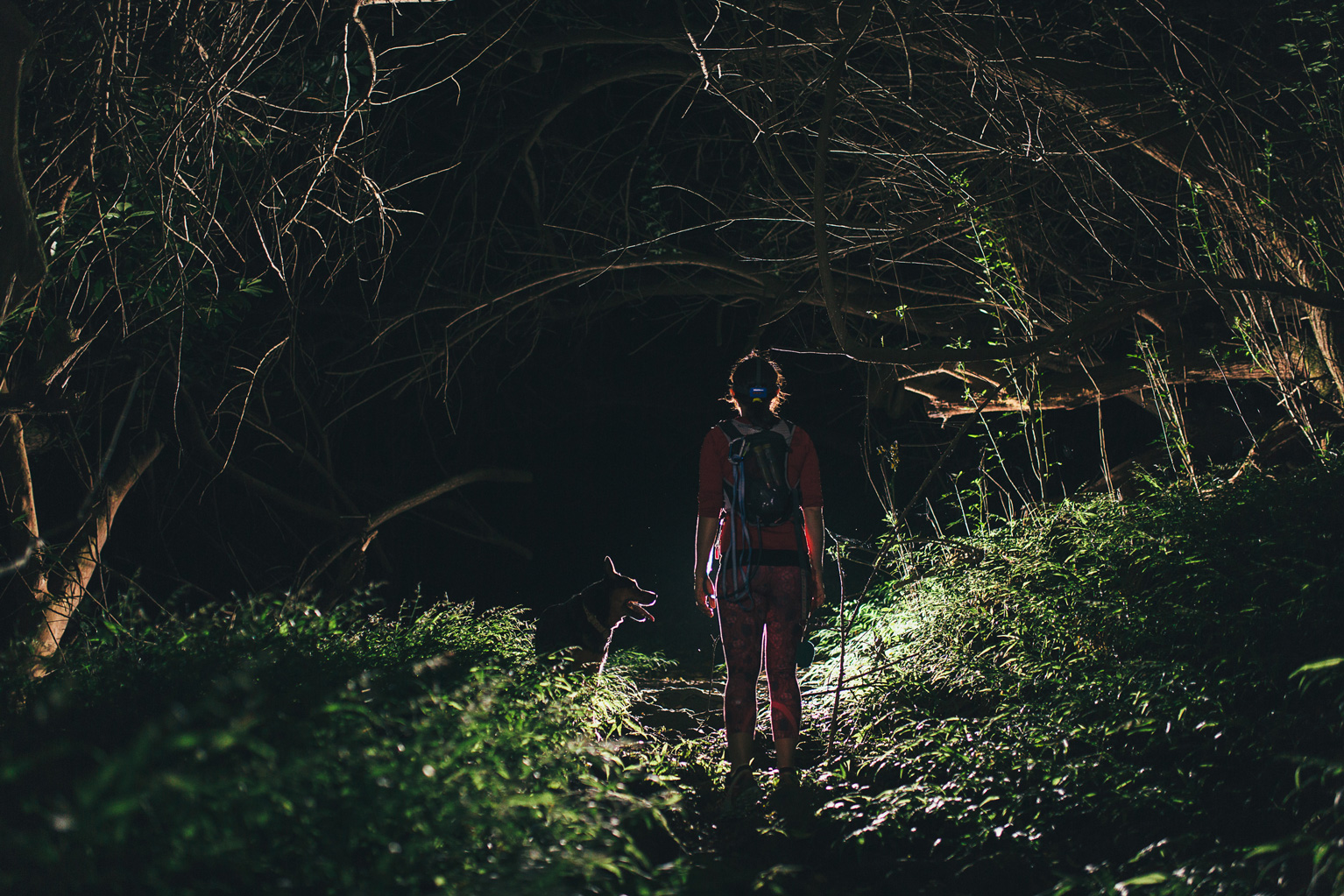Images by Meagan Suzuki
In the daylight, nature is in full-frontal forest grandeur, revealing her expanse and layers, her sheer and variegated faces, her remote, unreachable ridgeline. Crawling ferns border mulch; vines shroud branches; wild red gingers and violet orchids burst from tropical green; turkey tail mushrooms, with their concentric mesa-colored bands, give dead wood new life. Framing all this small-scale beauty is the broad, majestic overstory, its intricate leaf patterns reverse-sunprinted in panorama against the sky. It’s a symphony of sights and sounds. Why would anyone walk intentionally in the darkness, where one can see only single notes of the forest? What can be found in the night?
I began foraging in the dark as an accident of hiking after sundown—which was the result of working all day in a kitchen. For most of my years as a chef, I chased the sun, as if its setting meant the outdoors were shutting for the eve. I’d rush to finish cooking and cleaning, grab my dogs, hit the trail. I was frenzied. I felt the constant disappointment of running out of time, not realizing that the best time of day was no time of day at all. I am a chef who dreams of a treehouse existence, meals made by campfire and imu, using the earth to cook itself, à la Francis Mallmann, but minus whole animals. I love work, but acknowledge daily the strangeness of using an air conditioner in the same vicinity as an oven. At every chance, I recalibrate to the wild, where I cannot control the environment with a dial, where I can undo commercial connection to ingredients, and where I can value plants for their lush landscape alone.

Then, I settled for the night, and fell in love, despite its lesser hues and limited depths. It happened the same with the night as the way one falls in love with a person—staying up late, giddy, stumbling, and, you know, peering beneath every decaying log for signs of fungi. With the night, I would never get sunburned, but my heart could still skip with every sudden rustle from wild pigs or creak of branches.
During day foraging, I consistently mistake peeling bark for pepeiao (Auricularia auricula-judae). Pepeiao is brown, bark is brown—it is not an easy find. But in the dark, lit by a singular beam of light, pepeiao blooms from rotting kukui branches. Snow fungus (Tremella fuciformis) also becomes ethereal. It seems to have fallen from the sky, settling like gelatinous coral on a trailside trellis of dry branches. The sensory conspicuity of fungus exists in natural darkness and unnatural light. Liliko‘i, guava, mountain apple, gotu kola, hō‘i‘o fern—all that can be found in the day can be found at night. But in the dark, when the forest enters my senses like poetry, discovery feels serendipitous. A rope swing dangling among the trees is a noose, ‘o‘opu is glitter caught in a stream, a waterfall has no beginning. Evening prosody is heavy breathing surrounded by stillness. The smallest finds, such as a sleeping Jackson chameleon, is extraordinary, perhaps because I never expected to find anything marvelous at all in the dark.

I struggle with sleep. As a teenager, I often woke up hyperventilating. The doctor attributed these episodes to allergies. In my early 20s, I learned about choking ghosts and nocturnal panic attacks, and I wasn’t sure which disturbed me more—the possibility of getting strangled by that chick from The Ring, or that my chemical composition could strum up spontaneous terror mid-slumber. I conceded to sleep-inducing pharmaceuticals, despite an otherwise hippie lifestyle—anything to turn the lights off. In my mid-30s, antidepressants upgraded my sleeping ability with epic 12-hour power naps, but I would never wake up completely, and also I had no feelings. In 2016, I weaned myself off all the easy little pills, instead brewing potent bedtime teas and trying to muffle my thoughts with strange whispered stories from strangers. (The sleepless know there is a vast online video library of noises and narratives, such as “writing with a pencil” and “spa facial role play,” that are supposed to trigger relaxation.) Every night, I approached my bed with longing for an easy descent, layered beneath apprehension that it will never be easy, that sleep and I are star-crossed. I live at the end of a silent country road with no street lights, yet my body echoes with sirens.
Like night-blooming cereus, I consider myself one of those strange species that prefers to emerge when no one’s watching. Hiking is already an introvert-friendly activity, but night hiking takes it up a level because you are treading an absolutely empty path while most are inside, resting. These nights I often choose the trail, its sleeping creatures and unexpected edible delights, to stall sleep. I don’t know how to slip into slumber, but I know how to explore the dark—with steady steps, a good headlamp (that becomes a beacon for every airborne bug in the forest to join the rave in front of your face), and the remembrance that heightened vigilance is a reflex to darkness, not a necessity. Darkness transforms the familiar. As I trace a ridge between two valleys, the distant city—with its buildings, its houses, its lit and lined streets—shrinks beneath the black, endless expanse. Hiking ahead of my friends on a rare late-night group trek and seeing only their headlamps bob steadily down the switchbacks, I wonder if residents of the valley below might mistake our movements for night marchers, if not for the laughter, making light of our unease.

Jennifer Meleana Hee is a chef at Juicy Brew café. There are flowers that only bloom in the night; she considers herself one of those strange species that prefers to emerge when nobody’s watching.

